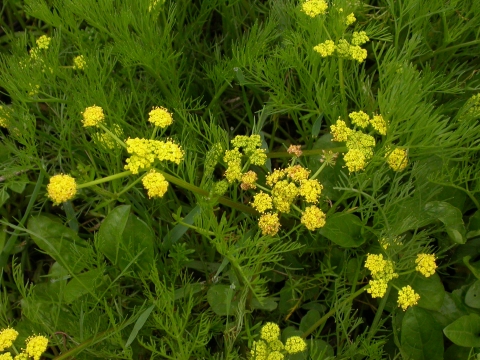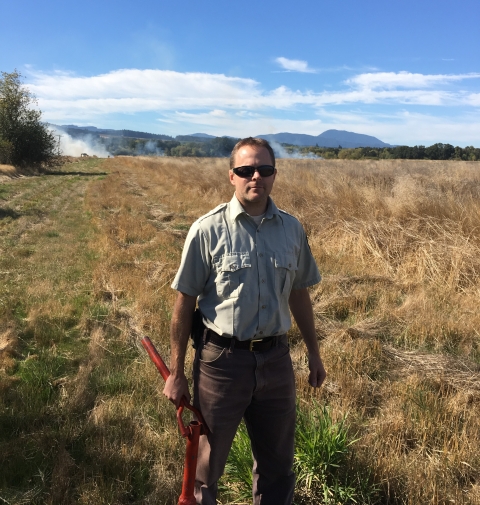This year is the 50th anniversary of the Endangered Species Act, a law that has been a powerful catalyst for conservation of America’s most treasured fish, wildlife, plants and their habitats. In the Pacific Region, our Tribes, state and federal agencies, and partners have joined with our dedicated staff to be the driving force behind the successes we share and the strength ensuring we can address the challenges ahead. Celebrate this milestone with us in this collection of stories as we reflect on past successes, assess current challenges, and envision an equally bright future for the next 50 years and beyond.
What is your job title?
I am a Partners for Fish and Wildlife Biologist for the US Fish and Wildlife Service (Service) and I work out of the Willamette Valley National Wildlife Refuge Complex (WVNWRC), in Benton County, Oregon. I work with landowners and other partners to achieve habitat conservation on non-federal lands for the benefit of rare and declining habitats and their associated wildlife. The majority of conservation opportunities are located on non-federal property, so it’s extremely important that we leverage these partnerships if we hope to be successful in recovering species and protecting habitat.
How have you worked to help recover Bradshaw’s desert parsley and fenders blue butterfly?
The Service created the Recovery Plan for the Prairie Species of the Willamette Valley and Southwest Washington, which is the supporting document that outlines the recovery needs we want to accomplish in the valley. The OFWO along with other partners, such as the Institute for Applied Ecology and local universities, have done a great deal of research on vegetative management techniques (such as mowing, spraying and burning) to be sure that the positive effects of these actions on butterflies outweigh the negative effects.
Using this information, we can write conservation actions into the Programmatic Biological Opinion that greatly streamlines Endangered Species Act (ESA) Section 7 Section 7
Section 7 Consultation
The Endangered Species Act (ESA) directs all Federal agencies to work to conserve endangered and threatened species and to use their authorities to further the purposes of the Act. Section 7 of the Act, called "Interagency Cooperation," is the mechanism by which Federal agencies ensure the actions they take, including those they fund or authorize, do not jeopardize the existence of any listed species.
Learn more about Section 7 compliance process and facilitates our work on refuges and partnering lands. Under Section 7 of the ESA, Federal entities must consult with the Service when a project could affect a listed species, in order to mitigate negative effects to the species or habitat.
The OFWO has also provided a Programmatic Safe Harbor Agreement, which has streamlined the Service’s ability to provide regulatory assurance to landowners who want to conserve fenders blue butterfly, making the job of the Partners Program biologists much easier. The OFWO has also put a great deal of effort into the production of plant materials to supplement and augment efforts to improve the needed plant communities in these habitats.
The WVNWRC refuges have put a lot of staff time, equipment hours, and fire and fuels management effort into restoring and managing these species, providing Partners Program, Fire Program, and refuge equipment for working both on and off of refuge lands with our conservation partners. Hundreds of acres of prairies and savannas are burned, mowed, and/or treated with herbicides each year by the WVNWRC for the benefit of ESA listed prairie species both on and off refuge. As a result of our efforts, we have seen increases in Bradshaw’s desert parsley and fenders blue butterfly in the areas that we have treated.
What do you do on a day to day basis?
I am a member of a team that works extensively on prairie restoration, contributing to the recovery of seven listed species — two of these are the Fenders Blue Butterfly and Bradshaw’s lomatium, also known as Bradshaw’s desert parsley.
Both of these species are native to the Willamette Valley in Oregon and require native prairie habitat. This part of the state is extremely fertile and is a major agricultural region. Because temperatures in this area are mild, the valley has 365-day growing season. Abundant rainfall and productive soils, in addition to a long growing season, means the area is great for agriculture, but it is also perfect for invasive species invasive species
An invasive species is any plant or animal that has spread or been introduced into a new area where they are, or could, cause harm to the environment, economy, or human, animal, or plant health. Their unwelcome presence can destroy ecosystems and cost millions of dollars.
Learn more about invasive species and vegetative succession. The loss of habitat from human activities and the encroachment of invasive species has pushed these species toward extinction.
The Willamette Valley National Wildlife Refuge Complex (WVNWRC) and the Oregon Fish and Wildlife Office (OFWO) have been working closely together for more than 20 years on conservation, restoration, and management of listed prairie plants and butterflies.
It takes a lot of consistent effort to maintain habitat for these species. The OFWO has worked hard to make sure the WVNWRC and other partners have the tools to effectively manage habitat for these species.
How have you worked to help recover Bradshaw’s desert parsley and fenders blue butterfly?
The Service created the Recovery Plan for the Prairie Species of the Willamette Valley and Southwest Washington, which is the supporting document that outlines the recovery needs we want to accomplish in the valley. The OFWO along with other partners, such as the Institute for Applied Ecology and local universities, have done a great deal of research on vegetative management techniques (such as mowing, spraying and burning) to be sure that the positive effects of these actions on butterflies outweigh the negative effects.
Using this information, we can write conservation actions into the Programmatic Biological Opinion that greatly streamlines Endangered Species Act (ESA) Section 7 compliance process and facilitates our work on refuges and partnering lands. Under Section 7 of the ESA, Federal entities must consult with the Service when a project could affect a listed species, in order to mitigate negative effects to the species or habitat.
The OFWO has also provided a Programmatic Safe Harbor Agreement, which has streamlined the Service’s ability to provide regulatory assurance to landowners who want to conserve fenders blue butterfly, making the job of the Partners Program biologists much easier. The OFWO has also put a great deal of effort into the production of plant materials to supplement and augment efforts to improve the needed plant communities in these habitats.
The WVNWRC refuges have put a lot of staff time, equipment hours, and fire and fuels management effort into restoring and managing these species, providing Partners Program, Fire Program, and refuge equipment for working both on and off of refuge lands with our conservation partners. Hundreds of acres of prairies and savannas are burned, mowed, and/or treated with herbicides each year by the WVNWRC for the benefit of ESA listed prairie species both on and off refuge. As a result of our efforts, we have seen increases in Bradshaw’s desert parsley and fenders blue butterfly in the areas that we have treated.
What led to the success of these partnerships?
I think a major aspect of the successes of this effort has been the trust established between FWS programs, which has maximized our ability to achieve conservation. This is not always easy, but the success of this effort has shown that it’s possible and effective. The OFWO trusts that the WVNWRC and partners have the knowledge and desire to be successful in restoration and management and a good investment of recovery program resources. Refuges and associated programs trust that the OFWO is doing all it can to streamline processes and provide what tools, funding, plant materials, and support that is available to allow the Service to be a good partner to cooperating entities. Consistency of key staff are an important part of this.
It has taken many years and the combined efforts of many individuals to help in the recovery of these species. Chris Seal, another Partners for Fish and Wildlife Biologist, and I currently lead Partners Program efforts on non-refuge lands and have been working in these habitats, on these species, with these partners for the past 20 years. In that time, we have worked with more than 40 landowners that have populations of Fender’s blue butterfly and Bradshaw’s desert parsley on their property.
Leadership at the WVNWRC has been consistent and dedicated to building these partnerships. Over the last 20 years, the Refuge Biologist has changed only once and Project Leader only twice. And, the equipment operator at Baskett Slough NWR, who has a wildlife science degree, has also been there for 20 years. Key staff at the OFWO, Mikki Collins and Jeff Dillion have worked on these species for the last 20 years. And, many other key positions have been here for a decade or more. This is a huge amount of institutional knowledge and interpersonal relationships that has led to this trust within and between Service programs as well as the external partners that have made this all possible.
What is one of your best memories from working in the field?
I really enjoy seeing the landowners we have worked with become spokespersons for conservation work. When they are inspired and start advocating to other landowners that they should do restoration as well, it feels like we are creating a legacy that will last much longer than our project. Getting to see one of our landowners give a presentation to 100 people about their project makes me feel like I’ve had a lasting effect.
How has the Covid-19 pandemic affected this work?
COVID-19 has added a lot of logistical issues. We have a crew of excellent equipment operators who utilize refuge-owned equipment to get much of our work done. Sharing of this equipment among multiple operators has become more time consuming as we try not to quickly switch out operators plus disinfecting equipment, etc. Carpooling has become a thing of the past. We often need to have equipment at field sites for several days so there is a need for vehicle shuttling. Spouses have actually been signing up as volunteers to assist with shuttling vehicles in order to prevent staff from having to ride together. I meet so many people and visit so many landowners that I still have not gotten used to not shaking people’s hands. Despite these challenges, we have had good leadership willing to adapt our practices so conservation and habitat restoration work can continue.






